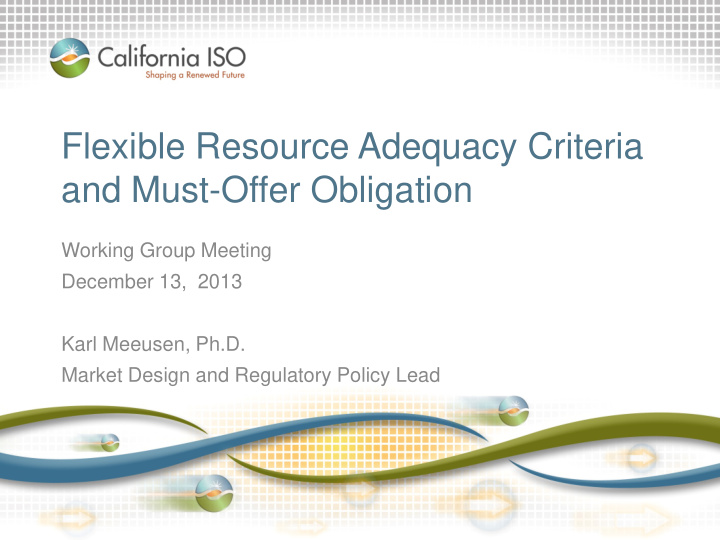



Flexible Resource Adequacy Criteria and Must-Offer Obligation Working Group Meeting December 13, 2013 Karl Meeusen, Ph.D. Market Design and Regulatory Policy Lead
Outline • Must offer obligation • Allocation of flexible capacity resources to local regulatory authorities • Standard flexible capacity product accounting and pricing Page 2
Outlining the ISO’s flexible capacity needs: The flock of ducks (forecasted March 2016) Page 3
Why the need for change • Tech specific offer obligations were designed to provide feasible solutions for a wide range of resources including DR, storage, and VERs • Stakeholders asserted that technology based offer obligations were – Complex – Discriminatory – Might not ensure the ISO has the sufficient flexible capacity • ISO is considering a generalized needs based – Blocked or bucketed operational needs Page 4
Trying to categorize ramping needs A: The maximum 3-hour net-load ramp for a month B: The smallest daily maximum daily 3-hour net-load ramp in a month C: The largest secondary 3-hour net load ramp of the month (i.e. the largest ramp on days that have bimodal ramping) Image is for illustrative purposes only and does not represent actual data Page 5
Preliminary bucket offer-obligations proposal (actual percentages still under development) • Bucket 1: 24 hour offer obligation, no use-limitations– Minimum of 50% of total flexible capacity showing • Bucket 2: 17 hour offer obligation, At least two start and minimum of 6 hours of run time (replacement required for ULRs) – Maximum of 50% • Bucket 3: 5 hour seasonally determined offer obligation, at least one start per day and minimum of 3 hours of run time (replacement required for ULRs) – Maximum of 20% • Bucket 4: 5 hour seasonally determined offer obligation, at least one start per day and minimum of 3 hours of run time and available for at least 5 flexibility based dispatches per month (no replacement required for ULRs) – Maximum of 5% Page 6
The ISO is still assessing all implications of switching to the generalized needs based approach • Resources types – Offer obligations – SFCP availability and compensation – Supply plans • LSEs/LRAs – Allocations – Replacement/substitution – Backstop – RA showings Page 7
The ISO’s most recent proposal • ISO proposes using an allocation methodology which is consistent with the system requirement determination based on the maximum net load ramp • ISO believes that allocating an RA requirement to generating resource is a significant change to the current RA construct. – This proposal may merit additional consideration, such changes to the RA construct is beyond the scope of FRAC-MOO Page 8
Flexible capacity requirement is split into its two component parts to determine the allocation • Maximum of the Most Severe Single Contingency or 3.5 percent of forecasted coincident peak – Allocated to LRA based on peak-load ratio share • The largest 3-hour net-load ramp is decomposed into four components to determine the LRA’s allocation Allocation* = Δ Load – Δ Wind Output – Δ Solar PV – Δ Solar Thermal * Changes in DG component captured in Δ Load Page 9
Pricing the Standard Flexible Capacity Product • The ISO has considered using – CPUC RA pricing data – Flexible ramping constraint • Other proposals from stakeholders include – Divide the flexible ramping constraint costs by the flexible capacity requirement (NRG) – Assess regulation ancillary service price and derive price per/kw-month (CDWR) • Adder price (monthly) = Reg up price (monthly average) – CPM price Page 10
Options for SFCP moving forward • Continue developing one of the previously discussed options • Defer until a later date – SFCP would not go into place until 2016 – Other stakeholder initiative may provide additional information for pricing SFCP (i.e. Flexible Ramping Product, Reliability Services Auction, etc.) Page 11
Proposed timing • ISO proposes to take final FRAC-MOO proposal to the March board meeting – Fifth revised draft straw proposal scheduled for early January – Draft final proposal in early February Page 12
Recommend
More recommend